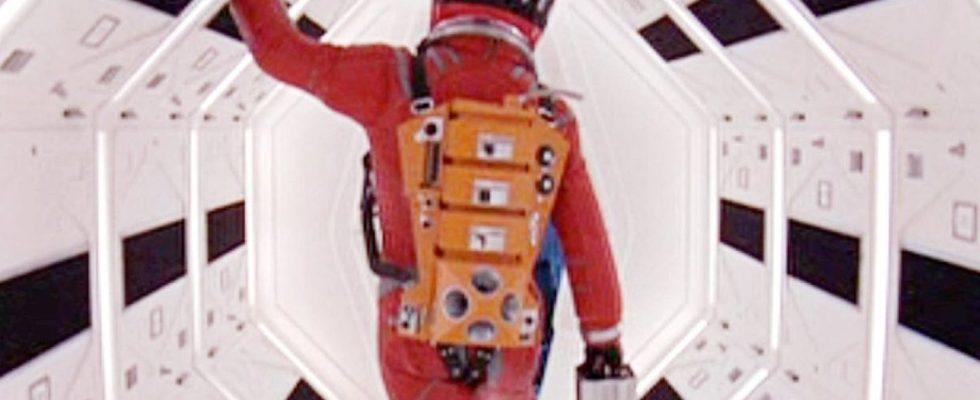“2001: A Space Odyssey” turns 55
A quantum leap in sci-fi film
2001: A Space Odyssey was released in US theaters on April 3, 1968.
© imago images/Mary Evans
Stanley Kubrick’s “2001: A Space Odyssey” was released in cinemas exactly 55 years ago. The sci-fi masterpiece became formative for its genre.
Stanley Kubrick (1928-1999) revolutionized science fiction film 55 years ago with his epochal cinematic masterpiece “2001: A Space Odyssey”. Even before the first moon landing in 1969, Kubrick showed cinema viewers hypnotic, realistic-looking images of the universe in his 143-minute, visionary film using sophisticated special effects.
At the same time, the director, who is considered a perfectionist, created a cinematic puzzle that is abstract and inaccessible and never provides easy answers. “You are free to speculate as you wish about the philosophical and allegorical meaning of the film”, the filmmaker himself explained in an interview with “Playboy” in 1968.
The images of outer space
When production of “2001: A Space Odyssey”, as the film was originally titled, began in 1964, the high-resolution, color images and video recordings of space that we know today did not yet exist. Kubrick and his team scientifically envisioned what it would be like to float in orbit – and hit the mark with their vision.
For example, the real Canadian astronaut Chris Hadfield (63) to the images of space seen in “2001”.: “The way you see the earth, the speed at which you race across the planet, the wide curvature of the globe – in reality it is exactly as you suspected in ‘2001’”.
The US space agency NASA is also in a blog entry from 2014, which lists which future predictions from “2001” have come true so far: “The film […] provided a realistic preview of what our future in space might look like.”
Revolution in trick technology
During the production of “2001” in England, Kubrick and his team spared no expense or effort. The construction of a complete rotating set with a diameter of 12 meters, which represents the interior of the spaceship Discovery One, devoured the astronomical sum of 750,000 US dollars at the time.
Dubbed the “Ferris Wheel,” the set provided a convincing simulation of the artificial gravity that is said to exist onboard the spacecraft. Such earthly and grounded categories as above and below no longer existed in Kubrick’s unleashed vision.
A 15 meter long model of the most important spaceship in “2001: A Space Odyssey” was also produced in order to enable realistic-looking exterior shots using a number of camera tricks that were revolutionary at the time. The sci-fi standard established by Kubrick in “2001” was not reached again until the end of the following decade in new classics such as “Star Wars” (1977) or “Alien” (1979).
In the years that followed, Kubrick’s special effects guru Douglas Trumbull (1942-2022), who was only 22 years old when production began, played key roles in the sci-fi masterpieces “Silent in Space” (1972), “The Close Encounter of the Third… . Art” (1977) and “Blade Runner” (1982).
Yes, the special effects in “2001” were so convincing that for decades to come conspiracy theorists would claim that Kubrick helped NASA stage the moon landing.
Visionary film music and the most famous match cut in film history
There are also many other innovations in “2001: A Space Odyssey”. Kubrick’s work contains what is probably the most famous match cut in film history. Four million years ago, a primate tosses a bone—the first human tool—into the air, and its shape transforms into a white spacecraft, one of the most advanced tools mankind has ever created.
In that colossal leap in time – between those two shots – lies the entire history of mankind – and Stanley Kubrick’s reputation as a cerebral filmmaker was gone.
In addition, Kubrick’s innovative use of film music in “2001” is also inspiring. According to legend, the master director discarded an already completed score by the composer Alex North (1910-1991), and opted instead for a series of classical music pieces such as the Nietzsche-inspired “Also Sprach Zarathustra” by Richard Strauss (1864-1949), which sounds three times in “2001”.
Subsequent generations of filmmakers took up this, for the time, highly original use of previously released tracks as film music. For example, Francis Ford Coppola (83) not only played Richard Wagner’s (1813-1883) “Valkyrie Ride” in “Apocalypse Now”, but also “The End” by the Doors. A similar use of well-known pieces of music as film music is also indispensable in Quentin Tarantino’s (60) films.

